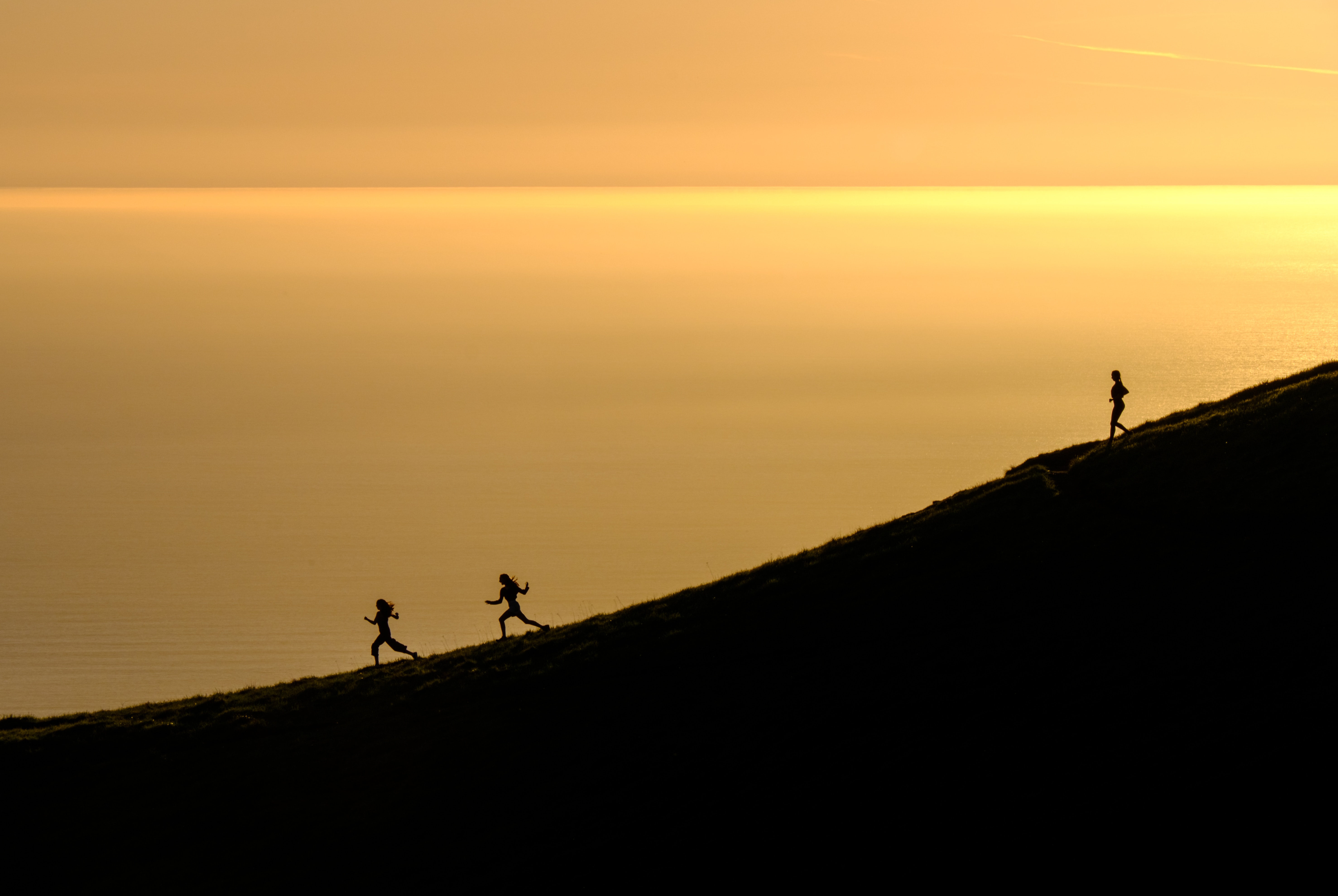Table of contents
Introduction
What comes to mind when you think of downhill running? Is it a feeling of exhilaration? Do you fly down the hill, the wind in your hair, never giving a thought to what might happen were you to stumble over a root or a rock? Or, do you take a slower approach to downhill running, more cautious than carefree?
Either way, you have probably experienced feeling pretty sore after a long, downhill run!
Intuitively, running downhill should be easier than running uphill, and from a cardiovascular standpoint, it is. But what makes downhill running so hard on our muscles?
Why is Downhill Running so Hard?
When we run downhill, our muscles lengthen rather than contract. As our muscles lengthen, they’re less activated, which means that it’s harder to bounce into that next step.
When we throw on the brakes and try to stop ourselves from losing control, our legs encounter far more force than they do on the flats. This force leads to knee pain, ankle twisting, or strained quads and calves.
Despite the pain that running downhill may cause, it actually isn’t bad for you at all. Running downhill incorrectly or not taking the time you need to recover from soreness, though, can lead to injury.
Training on hills, whether uphill or downhill, is a form of strength training! Becoming a better downhill runner goes hand in hand with strengthening your core and stabilizer muscles, increasing your leg speed and turnover, and building strength that will make you a better runner all around, not just on the hills.
When you’re running downhill, you use nearly every muscle in your body to stabilize and stay upright on your way down, but your quads truly bear the brunt of the pressure, controlling your momentum and experiencing the greatest muscle soreness post-run.
When most runners go downhill, they tend to lean back. When you lean back, your heel hits the ground first. Your body thinks of that heel strike as a sort of brake, and all your muscles tense up.
This tension can lead to delayed onset muscle soreness (DOMS), especially in the quads, which bear the brunt of most of this braking pressure.
DOMS occurs when the muscles become full of tiny tears. In reality, all of our training causes our muscles to tear, which is why recovery is so essential.
These tears repair, and our muscles come back stronger than before, meaning that you are getting stronger than before! Don’t be afraid of soreness. Know that you are getting stronger, but focus on extra recovery after a hilly training session.
10 Ways to Improve Your Downhill Running
1. Engage Your Core
Your core is SO much more than the washboard abs of the Insta stars we all drool over (don’t pretend you don’t). The core consists of several layers of muscles that connect your upper and lower body. The rectus abdominis, internal and external obliques, transverse abdominis, and pelvic floor are all essential to keeping you stable and upright on the trail.
When your core is engaged while running downhill, you are able to stay upright and stable. You’ll feel more confident, and your stride will be nimble, as if you were running on a much smoother surface.
2. Look Down The Trail
Next time you’re on the trail, note where your eyes are focused when you are running downhill. Are you looking for the next obstacle in your way, or do you focus your eyes forward a few meters?
Athletes who have experience in high-speed sports like mountain biking or skiing tend to look farther down the trail, as their bodies are quite soon about to be where their gaze rests. Why should runners be any different?
We don’t need to look directly down at our feet. Proprioceptors send direct impulses to our brains, which tells us where we are on the trail. Before you know it, you’re 100 meters down the trail. Did you notice every rock, stick, or root on the path? No way! But your brain did!
I’m always amazed when I zone out on the trail, only to realize half a mile later that I’m still running. I didn’t consciously take note of any obstacles in my path; my brain and body did it for me!
When you look straight down at your feet, you’re likely to miss an obstacle farther down the trail. This can lead to abrupt braking and added pressure on your muscles and joints.
Practice scanning the terrain 10 or 20 meters in front of you, instead of just looking at your feet. Of course, a glance down here and there won't hurt you, but if you practice scanning, you’ll notice that your core and hips engage more, you put on your “brakes” less, and your proprioception takes care of the rest.
3. Increase Your Turnover
Increasing turnover won’t just make you a better downhill runner, but a better runner in general. If you spend the time working to increase your cadence, you will see improvements throughout all aspects of the sport.
When you take smaller, quicker steps, you are less likely to heel strike, which puts the breaks on your body as you run downhill. When you take long, slow strides, you may overstride, landing with your leg too far in front of your body. This can put extra pressure on knees and hips.
A quick cadence also means that if you land on a root or a rock, you move off of it so quickly that you’ll be less likely to injure yourself on the trail. Practice Quiet Running
4. Practice Quiet Running
Quiet running is closely intertwined with increasing your cadence. The quicker and more controlled your steps are, the quieter you are, and the less negative impact the downhills will have on your body.
One way to increase your control on the trail is to wear less aggressive shoes on the trail. If you can control your footfalls and learn to run precisely in less grippy shoes, you’ll be even better come race day when you have on your most aggressive trail shoes.
5. Land on Your Forefoot
An essential piece of running quietly and precisely downhill is to focus on landing on your forefoot. As mentioned above, landing on your heel causes your body to brake, adding much more pressure on your body.
6. Swing Those Arms!
Running downhill smoothly and with confidence requires both strength and balance. Your arms help you stay balanced, so let them do their thing!
Your arms will swing, flail, and otherwise work naturally to keep you upright.
Additionally, the pace of your arms follows the pace of your legs. So, when attempting to increase your turnover, keep those arms moving, and your legs will follow.
7. Be Consistent
As with any new skill, it is crucial to be consistent with your downhill running training. You can build downhills into your easy runs, long runs, or workouts. You can also do exercises regularly that decrease the amount of delayed onset muscle soreness you feel after downhills.
Be wary, however, of the extra toll that this type of training can take on your body. Make sure to give yourself the recovery you need to repair after each session. DOMs ultimately result in muscle gains, but only if allowed to recover adequately between sessions.
8. Mimic Race Day Conditions
The feeling of downhill running is like no other. I genuinely believe that it’s an intrinsic reward worth working toward in itself.
However, most people are working toward a goal race. Make sure that your training mimics the course of your goal race.
If you’re training for a race like the Boston Marathon, make sure to practice running downhill on paved roads. If you’re training for a technical trail race, make sure to practice on the trails.
It may seem like obvious advice, but the roads and the trails can be different sports entirely. To be as prepared as possible, it is important to get on surfaces that will prepare you best for your specific goals.
9. Get Strong!
To decrease the amount of wear and tear on your muscles while downhill running and benefit you as a well-rounded runner, don’t skip leg day!
Strength training exercises can also be beneficial to runners who may not have easily accessible hills.
Some examples include:
- Squats
- Bulgarian Split Squats
- Split Squat Jumps
- Drills
- Lateral/forward Hops
- Supine Marching
- Grassy Hill Repeats
- Box jumps
- Running Down Stadium Stairs
- A Treadmill with a Decline Option
- Hip-Strengthening Exercises
- Core Work
10. Relax and Flow (Conclusion)
My favorite piece of advice for downhill running, given to me years ago by a veteran of the trails, is to relax into the experience and flow like water.
The next time you’re out on the trail, mindfully note the path water takes down a hill. Water always takes the path of least resistance, as should you.
After you’ve done the work to gain strength, increase your cadence, and get used to the awkward flailing of your arms, follow the water’s path.
Like water, let everything go. Rest your gaze out in front of you; let those proprioceptors do their work and flow.

Glenn Gabriel Bona
I'm a trail & ultra runner who's current goal is to run a sub-3 marathon and qualify for Boston!
Join 446,005 entrepreneurs who already have a head start.
Get free online marketing tips and resources delivered directly to your inbox.
No charge. Unsubscribe anytime.




Post a Comment